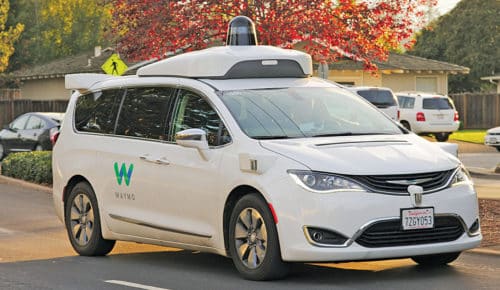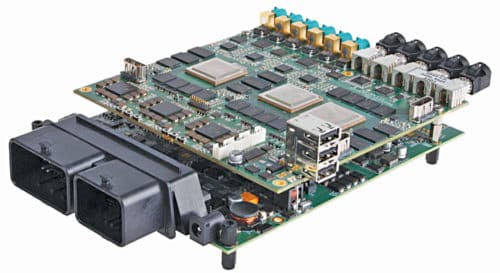Advancements in artificial intelligence (AI) have contributed to the growth of the automotive industry through the creation and evolution of such self-driving vehicles as cars, taxis, trucks, buses and bikes. Once driverless technology is fully developed, traffic collisions and accidents caused by human error, aggressive driving and other inconveniences will be substantially reduced.
Flying cars are no longer a fantasy or science fiction! With AI, autonomous, or self-driving, cars and autonomous flying cars are no more a futuristic dream. Companies like Boeing and Terrafugia have already developed fully-autonomous flying cars. With the emergence of AI, we can see many transformations in automotive and aviation industries. Although autonomous flying cars are not yet available in the market, self-driving cars are ready for commercial sale. Now, imagine our world with self-driving vehicles including cars, taxis, trucks, buses and bikes rolling out on highways, on the streets and on rural roads. This could become a reality with AI a few years from now.

Riding a self-driving car with much anticipation would be an exciting and thrilling experience for most of us. Everything in a driverless or self-driving car would seem magical when the steering wheel turns by itself, or the car automatically stops at a traffic light. This article will delve into AI trends driving the automotive industry, including self-driving cars and driver-assistance technologies.
Artificial intelligence
AI, as we all know, revolves around the use of algorithms or computer programs. Modern AI techniques are pervasive and numerous, therefore only a few AI technologies relevant to the automotive industry will be covered in this article.
AI is advancing at a great speed, and is making a great impact on automakers, vehicle owners and service providers in multiple ways. Many big players in the automotive industry are striving to automate their cars with AI-based technology. Many firms are also developing technology that can help with the installation of self-sufficient automobiles.
Self-driving cars
Japan’s Tsukuba Mechanical Engineering Laboratory developed the first self-driving car in 1977. Since then, many companies have come up with their versions of self-driving cars. Use of public roads for testing self-driving cars has been legalised and permitted in many cities in the US, Europe and Asia.
In 2016, Uber began testing self-driving cars on the streets in San Francisco, USA. In March 2018, one of its self-driving cars—a modified Volvo XC90—that was speeding at about 64.4kmph (40mph) in autonomous mode hit a woman and killed her. This was the first major accident where a self-driving car killed a human being. Testing was temporarily put on hold for a few months, but it resumed again the same year.

In December 2018, Waymo became the first company to commercialise a fully-autonomous taxi service in the US.
A number of components contribute to the functioning of self-driving cars. These cars are built with complex systems such as braking, lane changing, collision prevention, navigation and mapping, which are controlled and monitored by high-performance computers or intelligent systems.

One such intelligent system is RT-RK computer system based on TI processors. RT-RK Alpha development board is used for advanced warning systems, active control systems and semi-autonomous vehicle applications.
Mapping is one of the most important functions in these vehicles. It handles pre-programmed data on approximations of streetlights, obstructions and surroundings of the areas being driven in and around. It also handles the safety of passengers during high-risk situations like head-on collisions with pedestrians. AI algorithms help perform various functions by processing and analysing input data, such as sounds and images from various sensors.

Some technologies used in AI are described below.
Cloud computing
This is an ideal platform for staging and deploying AI technology in automotive applications. It includes analytics, Big Data access and centralised connectivity. Cloud-based AI platforms help drivers pay for their fuel purchases from inside the vehicle, find nearby restaurants and buy household items from relevant stores. Applications of AI-cloud platforms ensure that data is available when needed.
The Internet of Things
There are many sensors connected to the Internet every day, from weather to healthcare to smartphones. The combination of AI and the Internet of Things (IoT) devices allow manufacturers to update vehicles with additional features such as predictive maintenance, repair scheduling, identification of performance issues, medical emergencies and automatic toll collection.
Machine learning
Machine learning, when applied to devices and machines, can think and act almost like human beings using past data. It can make informed decisions based on what it has learned. Big Data, machine learning and AI generate highly sensitive autonomous systems to support the movement of vehicles.
Deep learning
This is the process for achieving machine learning. It is based on an artificial neural network that can learn and make intelligent decisions on its own. Deep learning methods make a lot of sense with large data sets as compared to machine learning.
Deep learning helps in advanced driving assistance systems, and in enhancing the quality and characteristics of autonomous vehicles. Bosch is in the process of developing supercomputers for vehicles. Whereas, Nvidia is working to develop deep learning technology to power them.
Cognitive technology
Pattern identification, natural language interpretation, ability to build knowledge and cognitive analytics make sense of information. Cognitive computing can handle conceptual/symbolic data rather than just pure data. Cognitive systems work like a human and can interpret a real-life situation with unstructured data, making high-level decisions in complex situations. Car manufacturers have now started incorporating this technology into their vehicles. This is because self-driving involves more than following a set of rules or algorithms—it also involves learning.
AI does more than respond to what is happening in the vehicle’s vicinity. Powerful deep learning algorithms can accurately predict what objects in the vehicle’s path are likely to do. AI constantly learns and adjusts the rules to navigate the road. The result is a virtual neural network of self-driving vehicles that learn as they go.
Infotainment systems
In-vehicle infotainment provides a combination of information and entertainment in the form of audio and video content, games, social networking, etc. Infotainment is a part of the technological interface of any modern car. AI improves infotainment systems in a better way. Information related to driver assistance, navigation, access to phone calls, messaging and the like is delivered seamlessly to the driver through infotainment systems.
Features like eye tracking, speech recognition, gesture recognition, monitoring driving and a database of natural languages are included in AI systems. Moreover, with AI’s connection to Big Data, infotainment systems can be used to suggest products and services to drivers.
Israeli automotive computer vision startup eyeSight has developed a program that recognises simple hand gestures to control the infotainment system without taking its eyes off the road.
AI driver assistance
AI can do more than autonomous driving, that is for sure! It keeps an eye on the human driver and ensures safe driving. AI software detects whether or not the driver is in the vehicle. AI monitors various sensors installed in the vehicle. A connected vehicle can check engine lights, oil lights and low-battery indicators, and detect problems before these affect vehicle operation. By monitoring thousands of sensors, AI can spot minute changes and component failures.
AI can identify dangerous situations and alert the driver, or take emergency control of the vehicle, to avoid an accident. Emergency braking, cross-traffic detection, blind spot monitoring and driver-assist steering can help avoid accidents, and save lives in the process.
eyeSight uses AI and deep learning to offer a plethora of in-car automotive solutions. Using advanced time-of-flight cameras and IR sensors, eyeSight’s AI software can detect many important key areas like facial recognition, eye tracking, upper-body detection and so on.
Facial recognition
These algorithms detect which driver is operating the vehicle. A husband, wife or a young adult can have his or her own preferences. The system can automatically adjust the seat, mirrors and temperature to suit the individual.
Eye tracking
On observing eye gaze, eye openness and head position, eyeSight can detect distracted driving and alert the driver to keep the eyes on the road. Drowsiness is detected by eye openness and head position, allowing the system to wake the driver up, if necessary.
Contextual control
The system tailors the content of the heads-up display (HUD) according to where the driver’s eyes are focused.
Upper-body detection
It detects the driver’s posture. Air bags can be deployed based on posture at the time of crash, reducing injuries.
AI automotive insurance
The insurance industry supports the use of AI in cars to help make risk assessments in real time. AI speeds up the process of filing claims when accidents do occur. Ant Financial has released its AI-powered video app in the Chinese auto market. The app enables drivers to perform their own auto damage assessment for their respective insurance companies.
On-screen instructions guide users to record video of their vehicle damage for insurance claim. AI quickly informs the drivers how to have their vehicle repaired, and what will be covered by insurance.
AI in automobile manufacturing
AI is changing what vehicles can do and how these are built. Assembly-line robots are nothing new. But now, AI-powered smart robots can work with their human counterparts. Collaborative robots use AI to sense what human workers are doing, and they adjust their motions to avoid injuring human co-workers.
Kia Motors has started developing wearable industrial robots for assembly lines. Wearable robots help protect workers’ knees, back and neck, while giving them the mobility and strength to perform tenuous jobs.
Automated guided vehicles are being used to move materials around automotive plants without human intervention. AI enables these delivery vehicles to identify objects in their paths and to adjust their route, accordingly.
Painting and welding robots, when powered by AI, can do more than follow a pre-programmed routine. AI empowers them to identify defects or irregularities in materials and alert quality control personnel.
The way forward
AI has captured maximum attention in automotive applications, particularly in driverless cars. This technology has brought a new breed of car driving. Huge computational needs in driverless cars have taken AI to a completely different level. Advancements in AI have contributed to the growth of the automotive industry through the creation and evolution of such self-driving vehicles as cars, taxis, trucks, buses and bikes.
Once driverless technology is fully developed, traffic collisions and accidents caused by human error, aggressive driving and other inconveniences will reduce substantially. AI not only enables autonomous driving and ensures safety of human drivers, it also helps in the manufacturing of vehicles. AI is already making dramatic changes in the automobile industry, including the way we drive and the way we interact with connected devices. The world of automotive industry with AI is going towards a new transformation, in a big way.







flying cars and self-driving cars are the dream came true technology for me. Al is now future of humans it will completely transform the automotive industry. I am very thankful for posting such a wonderful article this is very informative. keep posting such a wonderful articles.
Thanks for the feedback! I am glad you find it very informative.